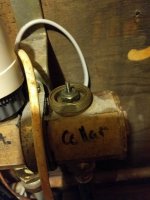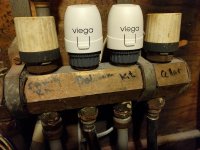Hello,
I purchased a house with an in floor water pipe radiant heat system with a buderus boiler and controller. I am looking to gain a deeper understanding of how the system works. Two of the actuators look old and I am planning to replace. When I take the actuator off and see the pin sticking up from the manifold, how can I test to make sure that part is working? I press down with a screwdriver and it goes down. Should I hear the sound of water when I do this?
Also, when I went down to look at things today, two of the actuator heads were popped up. It was a cooler day in the 60s and rainy. The controller was set to 64 and the room temperature was 70. I'm not sure why the system was on. There is the one controller in the living room that sets the temperature and there are 4 thermostats throughout the house that open or close the zone based on their temperature. I went and turned all those down to 60 and went as low as the controller would go and the actuator heads went back down. Why was the system running?
I uploaded a couple of pictures.

I purchased a house with an in floor water pipe radiant heat system with a buderus boiler and controller. I am looking to gain a deeper understanding of how the system works. Two of the actuators look old and I am planning to replace. When I take the actuator off and see the pin sticking up from the manifold, how can I test to make sure that part is working? I press down with a screwdriver and it goes down. Should I hear the sound of water when I do this?
Also, when I went down to look at things today, two of the actuator heads were popped up. It was a cooler day in the 60s and rainy. The controller was set to 64 and the room temperature was 70. I'm not sure why the system was on. There is the one controller in the living room that sets the temperature and there are 4 thermostats throughout the house that open or close the zone based on their temperature. I went and turned all those down to 60 and went as low as the controller would go and the actuator heads went back down. Why was the system running?
I uploaded a couple of pictures.


